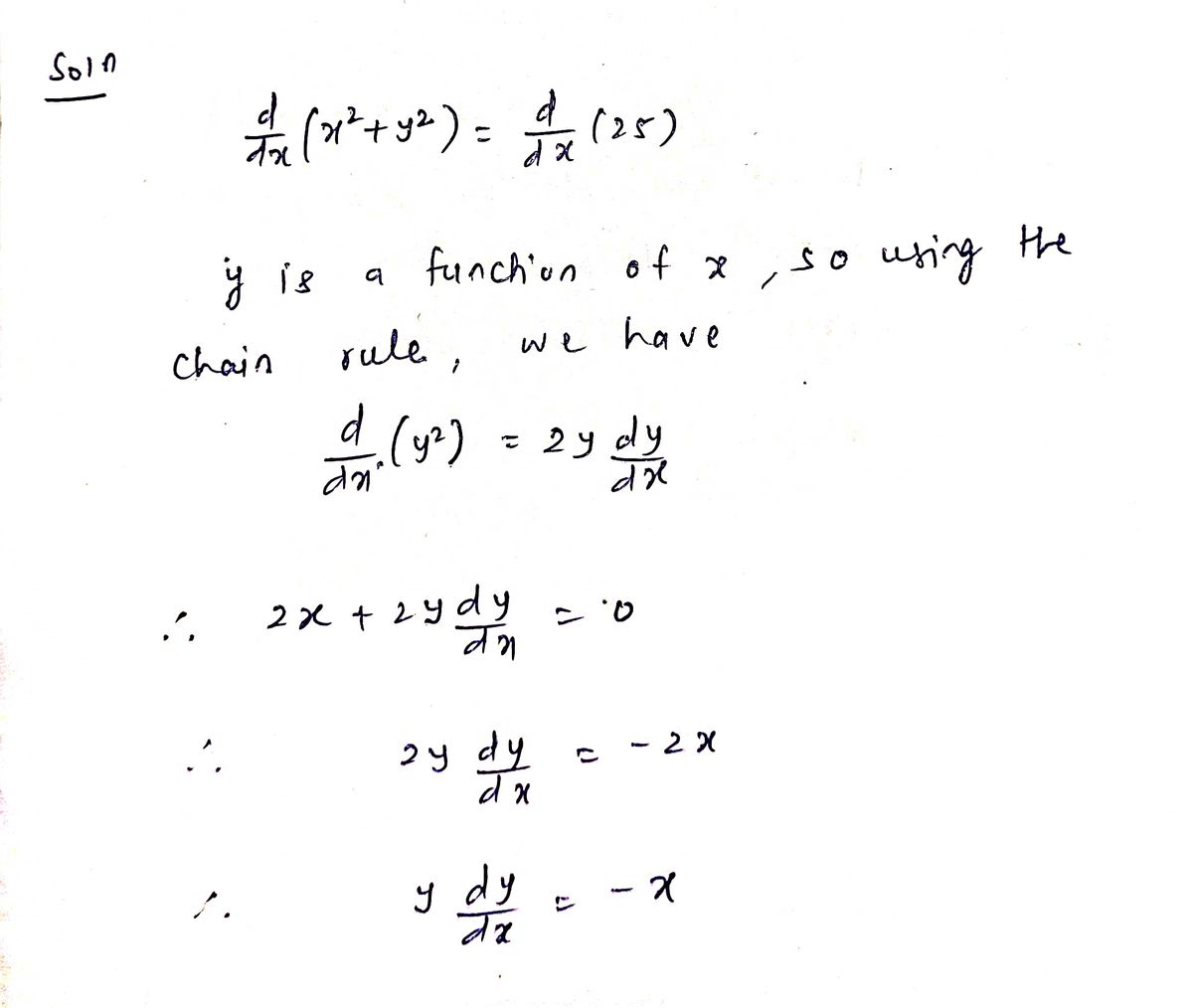을(22 + y7) %3D (25) d. da da d 을 (2) + 옮 (v?) 3D0 d dæ da a function of x and using the Chain Rule, we have dy 2y (y²) dx d. d. %3D %3D dx dy dx dy 2x + 2y dx uation for dy/dx:
을(22 + y7) %3D (25) d. da da d 을 (2) + 옮 (v?) 3D0 d dæ da a function of x and using the Chain Rule, we have dy 2y (y²) dx d. d. %3D %3D dx dy dx dy 2x + 2y dx uation for dy/dx:
Calculus: Early Transcendentals
8th Edition
ISBN:9781285741550
Author:James Stewart
Publisher:James Stewart
Chapter1: Functions And Models
Section: Chapter Questions
Problem 1RCC: (a) What is a function? What are its domain and range? (b) What is the graph of a function? (c) How...
Related questions
Question
Can anyone pls explain the part where (y^2)’ = d/dy (y^2). dy/dx
![Below is the transcription of the content from the image along with an explanation suitable for an educational website setting:
---
**Implicit Differentiation Example**
To differentiate the equation involving \(x^2 + y^2\), we start by taking the derivative of both sides:
\[
\frac{d}{dx} (x^2 + y^2) = \frac{d}{dx} (25)
\]
Since the derivative of a constant is zero, this simplifies to:
\[
\frac{d}{dx} (x^2) + \frac{d}{dx} (y^2) = 0
\]
Considering \(y\) as a function of \(x\) and using the Chain Rule, we have:
\[
\frac{d}{dx} (y^2) = \frac{d}{dy} (y^2) \cdot \frac{dy}{dx} = 2y \frac{dy}{dx}
\]
Substituting back into the equation gives:
\[
2x + 2y \frac{dy}{dx} = 0
\]
Solving for \(\frac{dy}{dx}\):
\[
\frac{dy}{dx} = -\frac{x}{y}
\]
**Note:**
1. The differentiation uses the Chain Rule to handle the derivative of \(y^2\), considering \(y\) as a function of \(x\).
2. The result \(\frac{dy}{dx} = -\frac{x}{y}\) represents the slope of the tangent line to the circle \(x^2 + y^2 = 25\) at any given point \((x, y)\) on the circle.
---
This explanation and transcription cover the process of implicit differentiation, illustrating how to derive the slope of a circle implicitly defined by the given equation.](/v2/_next/image?url=https%3A%2F%2Fcontent.bartleby.com%2Fqna-images%2Fquestion%2Ff41b80da-c327-4960-85a3-4b9f1b2a9a75%2F39ee29f7-a981-499d-9359-45fe0d8d774a%2Fbj5tlx_processed.jpeg&w=3840&q=75)
Transcribed Image Text:Below is the transcription of the content from the image along with an explanation suitable for an educational website setting:
---
**Implicit Differentiation Example**
To differentiate the equation involving \(x^2 + y^2\), we start by taking the derivative of both sides:
\[
\frac{d}{dx} (x^2 + y^2) = \frac{d}{dx} (25)
\]
Since the derivative of a constant is zero, this simplifies to:
\[
\frac{d}{dx} (x^2) + \frac{d}{dx} (y^2) = 0
\]
Considering \(y\) as a function of \(x\) and using the Chain Rule, we have:
\[
\frac{d}{dx} (y^2) = \frac{d}{dy} (y^2) \cdot \frac{dy}{dx} = 2y \frac{dy}{dx}
\]
Substituting back into the equation gives:
\[
2x + 2y \frac{dy}{dx} = 0
\]
Solving for \(\frac{dy}{dx}\):
\[
\frac{dy}{dx} = -\frac{x}{y}
\]
**Note:**
1. The differentiation uses the Chain Rule to handle the derivative of \(y^2\), considering \(y\) as a function of \(x\).
2. The result \(\frac{dy}{dx} = -\frac{x}{y}\) represents the slope of the tangent line to the circle \(x^2 + y^2 = 25\) at any given point \((x, y)\) on the circle.
---
This explanation and transcription cover the process of implicit differentiation, illustrating how to derive the slope of a circle implicitly defined by the given equation.
Expert Solution
Step 1

Step by step
Solved in 2 steps with 2 images

Recommended textbooks for you

Calculus: Early Transcendentals
Calculus
ISBN:
9781285741550
Author:
James Stewart
Publisher:
Cengage Learning

Thomas' Calculus (14th Edition)
Calculus
ISBN:
9780134438986
Author:
Joel R. Hass, Christopher E. Heil, Maurice D. Weir
Publisher:
PEARSON

Calculus: Early Transcendentals (3rd Edition)
Calculus
ISBN:
9780134763644
Author:
William L. Briggs, Lyle Cochran, Bernard Gillett, Eric Schulz
Publisher:
PEARSON

Calculus: Early Transcendentals
Calculus
ISBN:
9781285741550
Author:
James Stewart
Publisher:
Cengage Learning

Thomas' Calculus (14th Edition)
Calculus
ISBN:
9780134438986
Author:
Joel R. Hass, Christopher E. Heil, Maurice D. Weir
Publisher:
PEARSON

Calculus: Early Transcendentals (3rd Edition)
Calculus
ISBN:
9780134763644
Author:
William L. Briggs, Lyle Cochran, Bernard Gillett, Eric Schulz
Publisher:
PEARSON

Calculus: Early Transcendentals
Calculus
ISBN:
9781319050740
Author:
Jon Rogawski, Colin Adams, Robert Franzosa
Publisher:
W. H. Freeman


Calculus: Early Transcendental Functions
Calculus
ISBN:
9781337552516
Author:
Ron Larson, Bruce H. Edwards
Publisher:
Cengage Learning